Freshippo: Business Model Evolution in Alibaba's New Retail
VerifiedAdded on 2022/09/22
|11
|3280
|22
Case Study
AI Summary
This case study analyzes the evolution of Freshippo's business model within Alibaba's new retail platform in China. It explores the challenges Freshippo faced, including customer dissatisfaction with service quality and long delivery times, and the company's attempts to address these issues through various store models. The analysis covers the development of an integrated online-offline business model, value creation for customers, and strategies for capturing value. The study evaluates the effectiveness of different store formats like regular stores, F2 convenience stores, cloud supermarkets, and Hexiaoma stores. It also examines the first-mover advantage Freshippo leveraged. Recommendations include focusing on core strengths, improving customer service, and continuously innovating the business model to ensure sustainable, profitable growth in the competitive retail market. The case emphasizes the importance of customer satisfaction and adapting to evolving market demands.
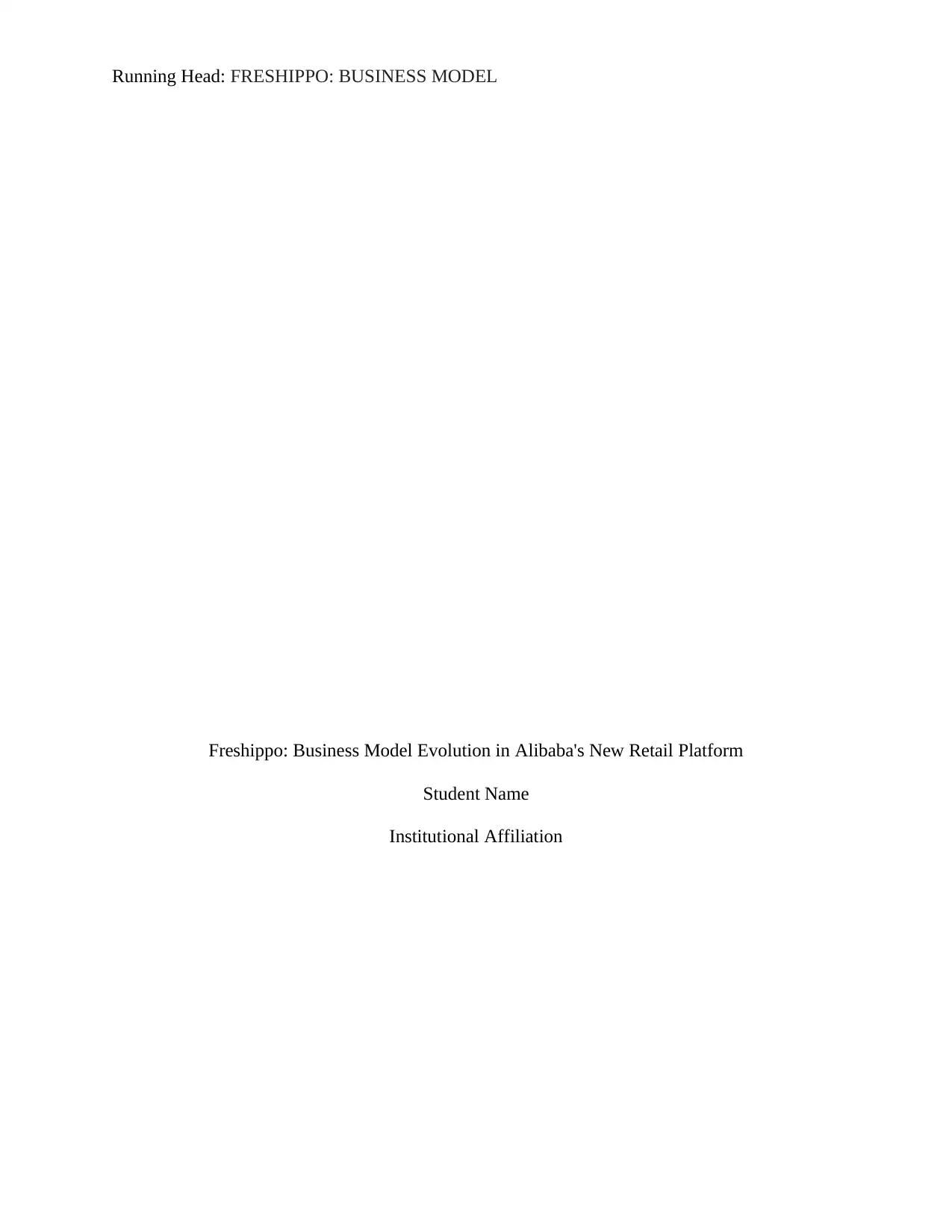
Running Head: FRESHIPPO: BUSINESS MODEL
Freshippo: Business Model Evolution in Alibaba's New Retail Platform
Student Name
Institutional Affiliation
Freshippo: Business Model Evolution in Alibaba's New Retail Platform
Student Name
Institutional Affiliation
Paraphrase This Document
Need a fresh take? Get an instant paraphrase of this document with our AI Paraphraser

FRESHIPPO: BUSINESS MODEL 2
Freshippo: Business Model Evolution in Alibaba's New Retail Platform
1. Introduction
The retail industry of China is thriving, and the vast prospects of business returns are
attracting numerous investors in this particular industry. Alibaba group is a notable name in the
Chinese retail industry that has come forward with a strategy of 'New Retail.' Alibaba group is
excessively focused on materializing potential gains from this new retail platform (Naidu et al.,
2019). It requires substantive changes and the evolution of existing business models for gaining
sustainable profitability. The given case study is focused on the existing business models of the
business of the Alibaba group named Freshippo. It elaborates on the operations of Freshippo to
highlight the favorable and unfavorable aspects of its business models. The case explains that Yi
from Freshippo proved himself as a vigilant entrepreneur and remained in close contact with
customers. It allowed Yi to understand the complaints and concerns of business customers.
Freshippo continued to make all possible arrangements to avoid the likelihood of customer
complaints (Kwak et al., 2019). In the present scenario, Freshippo realized that they are drifting
away from the core competencies and strengths of business by being disproportionately focused
on finding solutions for business weaknesses.
The case analysis report includes identification and description of major problems faced
by the customers, evaluation of business models and business decisions overtime, the
recommendation for the future, and a brief conclusion.
1.1. Problem Description
The movement by Alibaba to introduce new retail methods in the industry, Freshippo,
was initiated. Although Freshippo was developed with the underlying idea of a futuristic chain of
grocery, which was focused on the delivery of fresh food items, their customers seemed
unsatisfied. The basic problems were rooted in the evolution of the business model of Freshippo.
Freshippo: Business Model Evolution in Alibaba's New Retail Platform
1. Introduction
The retail industry of China is thriving, and the vast prospects of business returns are
attracting numerous investors in this particular industry. Alibaba group is a notable name in the
Chinese retail industry that has come forward with a strategy of 'New Retail.' Alibaba group is
excessively focused on materializing potential gains from this new retail platform (Naidu et al.,
2019). It requires substantive changes and the evolution of existing business models for gaining
sustainable profitability. The given case study is focused on the existing business models of the
business of the Alibaba group named Freshippo. It elaborates on the operations of Freshippo to
highlight the favorable and unfavorable aspects of its business models. The case explains that Yi
from Freshippo proved himself as a vigilant entrepreneur and remained in close contact with
customers. It allowed Yi to understand the complaints and concerns of business customers.
Freshippo continued to make all possible arrangements to avoid the likelihood of customer
complaints (Kwak et al., 2019). In the present scenario, Freshippo realized that they are drifting
away from the core competencies and strengths of business by being disproportionately focused
on finding solutions for business weaknesses.
The case analysis report includes identification and description of major problems faced
by the customers, evaluation of business models and business decisions overtime, the
recommendation for the future, and a brief conclusion.
1.1. Problem Description
The movement by Alibaba to introduce new retail methods in the industry, Freshippo,
was initiated. Although Freshippo was developed with the underlying idea of a futuristic chain of
grocery, which was focused on the delivery of fresh food items, their customers seemed
unsatisfied. The basic problems were rooted in the evolution of the business model of Freshippo.
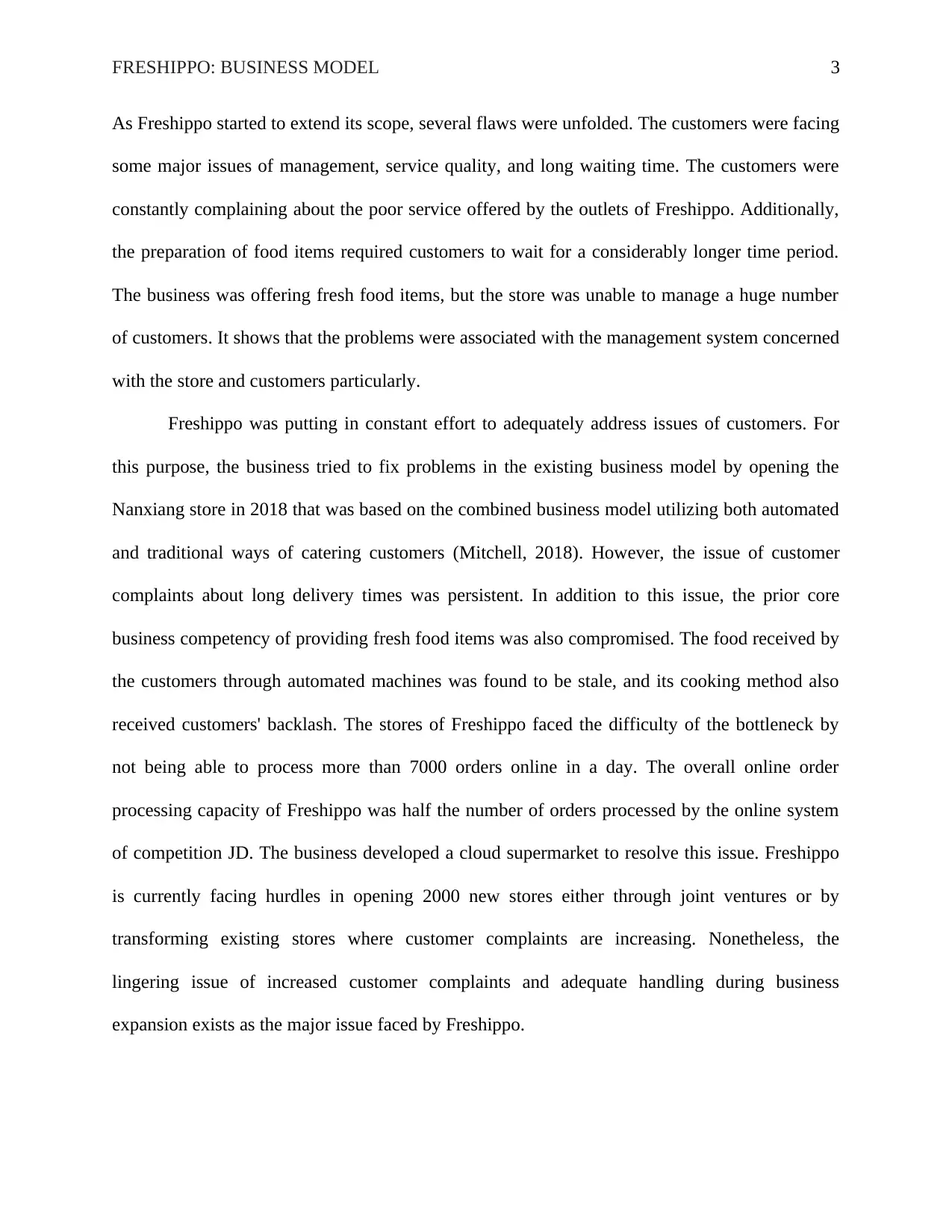
FRESHIPPO: BUSINESS MODEL 3
As Freshippo started to extend its scope, several flaws were unfolded. The customers were facing
some major issues of management, service quality, and long waiting time. The customers were
constantly complaining about the poor service offered by the outlets of Freshippo. Additionally,
the preparation of food items required customers to wait for a considerably longer time period.
The business was offering fresh food items, but the store was unable to manage a huge number
of customers. It shows that the problems were associated with the management system concerned
with the store and customers particularly.
Freshippo was putting in constant effort to adequately address issues of customers. For
this purpose, the business tried to fix problems in the existing business model by opening the
Nanxiang store in 2018 that was based on the combined business model utilizing both automated
and traditional ways of catering customers (Mitchell, 2018). However, the issue of customer
complaints about long delivery times was persistent. In addition to this issue, the prior core
business competency of providing fresh food items was also compromised. The food received by
the customers through automated machines was found to be stale, and its cooking method also
received customers' backlash. The stores of Freshippo faced the difficulty of the bottleneck by
not being able to process more than 7000 orders online in a day. The overall online order
processing capacity of Freshippo was half the number of orders processed by the online system
of competition JD. The business developed a cloud supermarket to resolve this issue. Freshippo
is currently facing hurdles in opening 2000 new stores either through joint ventures or by
transforming existing stores where customer complaints are increasing. Nonetheless, the
lingering issue of increased customer complaints and adequate handling during business
expansion exists as the major issue faced by Freshippo.
As Freshippo started to extend its scope, several flaws were unfolded. The customers were facing
some major issues of management, service quality, and long waiting time. The customers were
constantly complaining about the poor service offered by the outlets of Freshippo. Additionally,
the preparation of food items required customers to wait for a considerably longer time period.
The business was offering fresh food items, but the store was unable to manage a huge number
of customers. It shows that the problems were associated with the management system concerned
with the store and customers particularly.
Freshippo was putting in constant effort to adequately address issues of customers. For
this purpose, the business tried to fix problems in the existing business model by opening the
Nanxiang store in 2018 that was based on the combined business model utilizing both automated
and traditional ways of catering customers (Mitchell, 2018). However, the issue of customer
complaints about long delivery times was persistent. In addition to this issue, the prior core
business competency of providing fresh food items was also compromised. The food received by
the customers through automated machines was found to be stale, and its cooking method also
received customers' backlash. The stores of Freshippo faced the difficulty of the bottleneck by
not being able to process more than 7000 orders online in a day. The overall online order
processing capacity of Freshippo was half the number of orders processed by the online system
of competition JD. The business developed a cloud supermarket to resolve this issue. Freshippo
is currently facing hurdles in opening 2000 new stores either through joint ventures or by
transforming existing stores where customer complaints are increasing. Nonetheless, the
lingering issue of increased customer complaints and adequate handling during business
expansion exists as the major issue faced by Freshippo.
⊘ This is a preview!⊘
Do you want full access?
Subscribe today to unlock all pages.

Trusted by 1+ million students worldwide
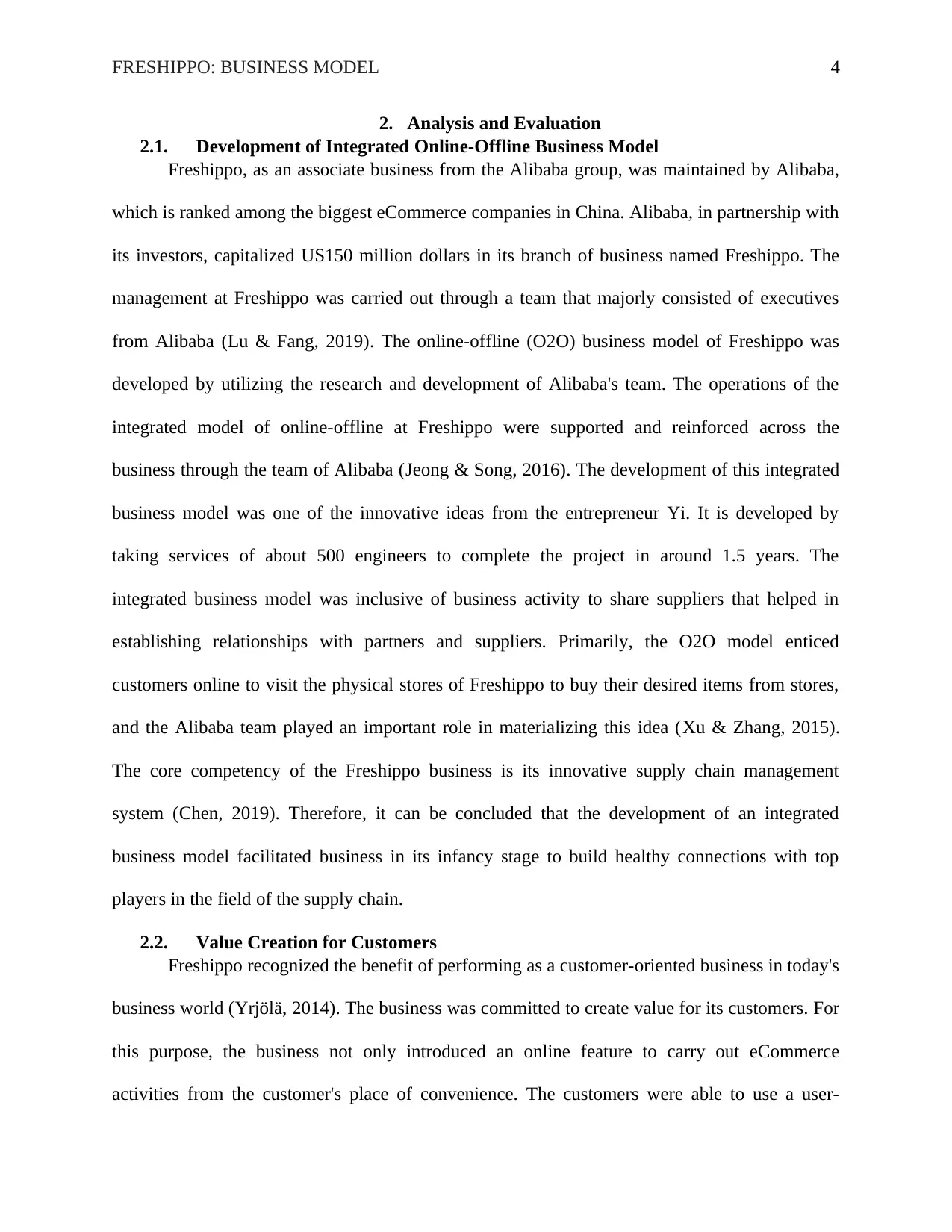
FRESHIPPO: BUSINESS MODEL 4
2. Analysis and Evaluation
2.1. Development of Integrated Online-Offline Business Model
Freshippo, as an associate business from the Alibaba group, was maintained by Alibaba,
which is ranked among the biggest eCommerce companies in China. Alibaba, in partnership with
its investors, capitalized US150 million dollars in its branch of business named Freshippo. The
management at Freshippo was carried out through a team that majorly consisted of executives
from Alibaba (Lu & Fang, 2019). The online-offline (O2O) business model of Freshippo was
developed by utilizing the research and development of Alibaba's team. The operations of the
integrated model of online-offline at Freshippo were supported and reinforced across the
business through the team of Alibaba (Jeong & Song, 2016). The development of this integrated
business model was one of the innovative ideas from the entrepreneur Yi. It is developed by
taking services of about 500 engineers to complete the project in around 1.5 years. The
integrated business model was inclusive of business activity to share suppliers that helped in
establishing relationships with partners and suppliers. Primarily, the O2O model enticed
customers online to visit the physical stores of Freshippo to buy their desired items from stores,
and the Alibaba team played an important role in materializing this idea (Xu & Zhang, 2015).
The core competency of the Freshippo business is its innovative supply chain management
system (Chen, 2019). Therefore, it can be concluded that the development of an integrated
business model facilitated business in its infancy stage to build healthy connections with top
players in the field of the supply chain.
2.2. Value Creation for Customers
Freshippo recognized the benefit of performing as a customer-oriented business in today's
business world (Yrjölä, 2014). The business was committed to create value for its customers. For
this purpose, the business not only introduced an online feature to carry out eCommerce
activities from the customer's place of convenience. The customers were able to use a user-
2. Analysis and Evaluation
2.1. Development of Integrated Online-Offline Business Model
Freshippo, as an associate business from the Alibaba group, was maintained by Alibaba,
which is ranked among the biggest eCommerce companies in China. Alibaba, in partnership with
its investors, capitalized US150 million dollars in its branch of business named Freshippo. The
management at Freshippo was carried out through a team that majorly consisted of executives
from Alibaba (Lu & Fang, 2019). The online-offline (O2O) business model of Freshippo was
developed by utilizing the research and development of Alibaba's team. The operations of the
integrated model of online-offline at Freshippo were supported and reinforced across the
business through the team of Alibaba (Jeong & Song, 2016). The development of this integrated
business model was one of the innovative ideas from the entrepreneur Yi. It is developed by
taking services of about 500 engineers to complete the project in around 1.5 years. The
integrated business model was inclusive of business activity to share suppliers that helped in
establishing relationships with partners and suppliers. Primarily, the O2O model enticed
customers online to visit the physical stores of Freshippo to buy their desired items from stores,
and the Alibaba team played an important role in materializing this idea (Xu & Zhang, 2015).
The core competency of the Freshippo business is its innovative supply chain management
system (Chen, 2019). Therefore, it can be concluded that the development of an integrated
business model facilitated business in its infancy stage to build healthy connections with top
players in the field of the supply chain.
2.2. Value Creation for Customers
Freshippo recognized the benefit of performing as a customer-oriented business in today's
business world (Yrjölä, 2014). The business was committed to create value for its customers. For
this purpose, the business not only introduced an online feature to carry out eCommerce
activities from the customer's place of convenience. The customers were able to use a user-
Paraphrase This Document
Need a fresh take? Get an instant paraphrase of this document with our AI Paraphraser
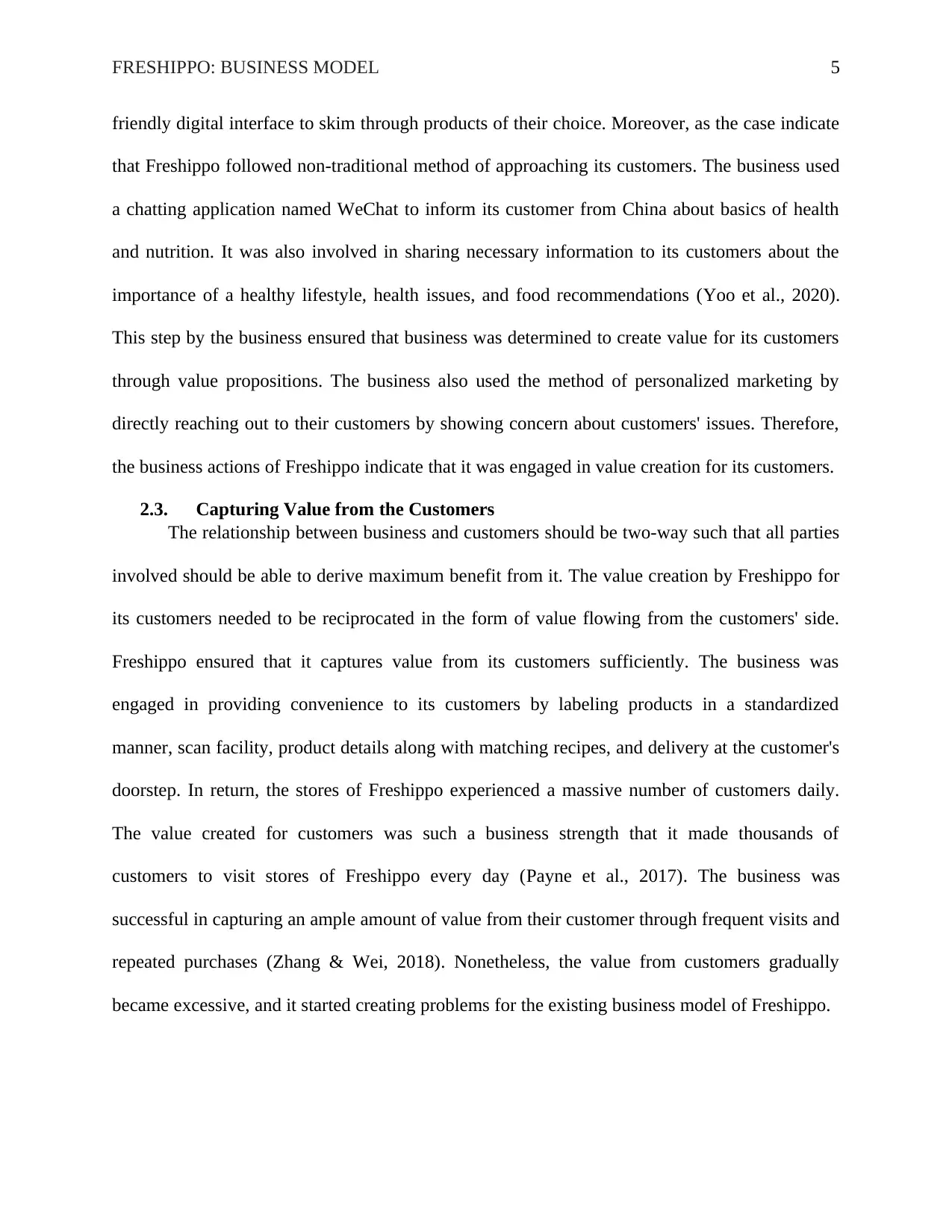
FRESHIPPO: BUSINESS MODEL 5
friendly digital interface to skim through products of their choice. Moreover, as the case indicate
that Freshippo followed non-traditional method of approaching its customers. The business used
a chatting application named WeChat to inform its customer from China about basics of health
and nutrition. It was also involved in sharing necessary information to its customers about the
importance of a healthy lifestyle, health issues, and food recommendations (Yoo et al., 2020).
This step by the business ensured that business was determined to create value for its customers
through value propositions. The business also used the method of personalized marketing by
directly reaching out to their customers by showing concern about customers' issues. Therefore,
the business actions of Freshippo indicate that it was engaged in value creation for its customers.
2.3. Capturing Value from the Customers
The relationship between business and customers should be two-way such that all parties
involved should be able to derive maximum benefit from it. The value creation by Freshippo for
its customers needed to be reciprocated in the form of value flowing from the customers' side.
Freshippo ensured that it captures value from its customers sufficiently. The business was
engaged in providing convenience to its customers by labeling products in a standardized
manner, scan facility, product details along with matching recipes, and delivery at the customer's
doorstep. In return, the stores of Freshippo experienced a massive number of customers daily.
The value created for customers was such a business strength that it made thousands of
customers to visit stores of Freshippo every day (Payne et al., 2017). The business was
successful in capturing an ample amount of value from their customer through frequent visits and
repeated purchases (Zhang & Wei, 2018). Nonetheless, the value from customers gradually
became excessive, and it started creating problems for the existing business model of Freshippo.
friendly digital interface to skim through products of their choice. Moreover, as the case indicate
that Freshippo followed non-traditional method of approaching its customers. The business used
a chatting application named WeChat to inform its customer from China about basics of health
and nutrition. It was also involved in sharing necessary information to its customers about the
importance of a healthy lifestyle, health issues, and food recommendations (Yoo et al., 2020).
This step by the business ensured that business was determined to create value for its customers
through value propositions. The business also used the method of personalized marketing by
directly reaching out to their customers by showing concern about customers' issues. Therefore,
the business actions of Freshippo indicate that it was engaged in value creation for its customers.
2.3. Capturing Value from the Customers
The relationship between business and customers should be two-way such that all parties
involved should be able to derive maximum benefit from it. The value creation by Freshippo for
its customers needed to be reciprocated in the form of value flowing from the customers' side.
Freshippo ensured that it captures value from its customers sufficiently. The business was
engaged in providing convenience to its customers by labeling products in a standardized
manner, scan facility, product details along with matching recipes, and delivery at the customer's
doorstep. In return, the stores of Freshippo experienced a massive number of customers daily.
The value created for customers was such a business strength that it made thousands of
customers to visit stores of Freshippo every day (Payne et al., 2017). The business was
successful in capturing an ample amount of value from their customer through frequent visits and
repeated purchases (Zhang & Wei, 2018). Nonetheless, the value from customers gradually
became excessive, and it started creating problems for the existing business model of Freshippo.
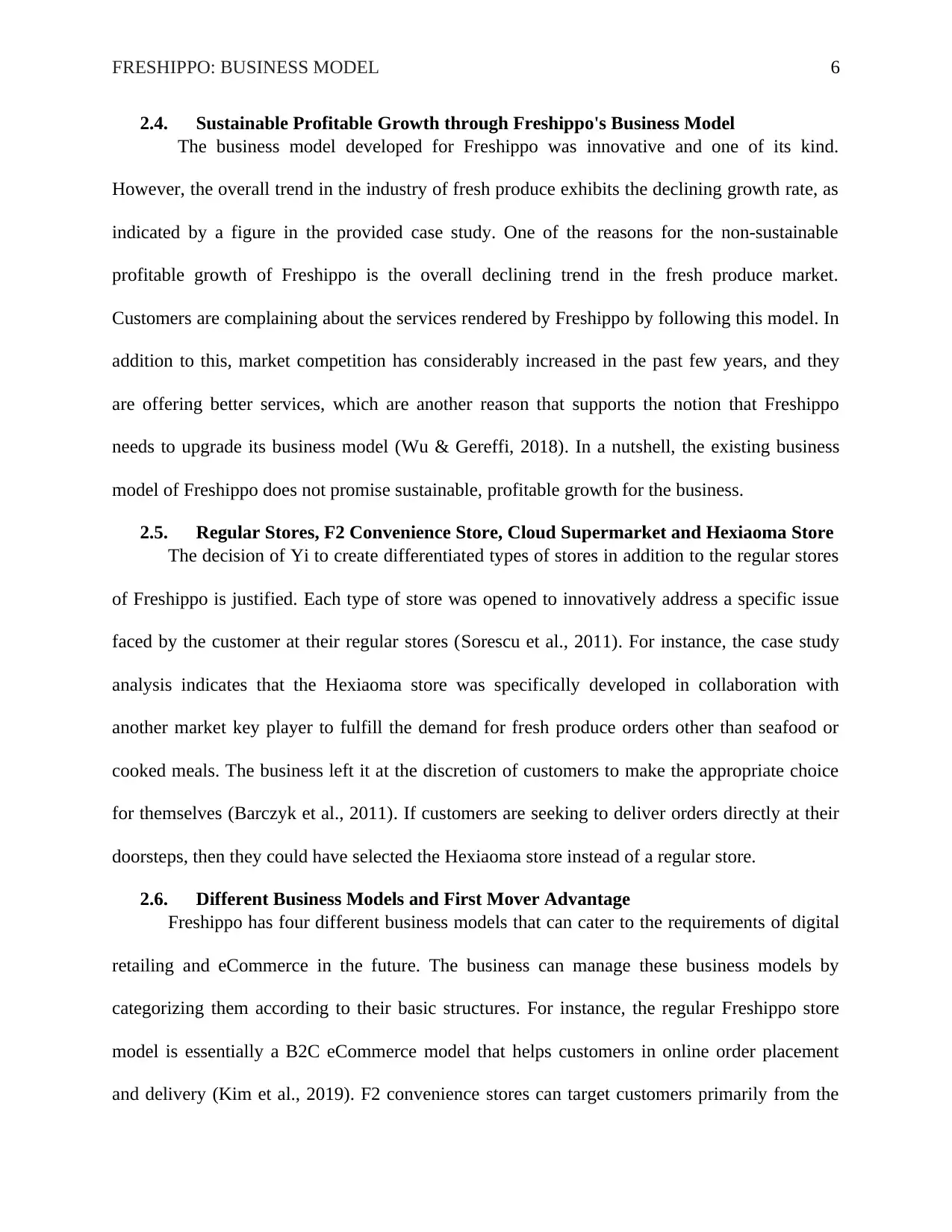
FRESHIPPO: BUSINESS MODEL 6
2.4. Sustainable Profitable Growth through Freshippo's Business Model
The business model developed for Freshippo was innovative and one of its kind.
However, the overall trend in the industry of fresh produce exhibits the declining growth rate, as
indicated by a figure in the provided case study. One of the reasons for the non-sustainable
profitable growth of Freshippo is the overall declining trend in the fresh produce market.
Customers are complaining about the services rendered by Freshippo by following this model. In
addition to this, market competition has considerably increased in the past few years, and they
are offering better services, which are another reason that supports the notion that Freshippo
needs to upgrade its business model (Wu & Gereffi, 2018). In a nutshell, the existing business
model of Freshippo does not promise sustainable, profitable growth for the business.
2.5. Regular Stores, F2 Convenience Store, Cloud Supermarket and Hexiaoma Store
The decision of Yi to create differentiated types of stores in addition to the regular stores
of Freshippo is justified. Each type of store was opened to innovatively address a specific issue
faced by the customer at their regular stores (Sorescu et al., 2011). For instance, the case study
analysis indicates that the Hexiaoma store was specifically developed in collaboration with
another market key player to fulfill the demand for fresh produce orders other than seafood or
cooked meals. The business left it at the discretion of customers to make the appropriate choice
for themselves (Barczyk et al., 2011). If customers are seeking to deliver orders directly at their
doorsteps, then they could have selected the Hexiaoma store instead of a regular store.
2.6. Different Business Models and First Mover Advantage
Freshippo has four different business models that can cater to the requirements of digital
retailing and eCommerce in the future. The business can manage these business models by
categorizing them according to their basic structures. For instance, the regular Freshippo store
model is essentially a B2C eCommerce model that helps customers in online order placement
and delivery (Kim et al., 2019). F2 convenience stores can target customers primarily from the
2.4. Sustainable Profitable Growth through Freshippo's Business Model
The business model developed for Freshippo was innovative and one of its kind.
However, the overall trend in the industry of fresh produce exhibits the declining growth rate, as
indicated by a figure in the provided case study. One of the reasons for the non-sustainable
profitable growth of Freshippo is the overall declining trend in the fresh produce market.
Customers are complaining about the services rendered by Freshippo by following this model. In
addition to this, market competition has considerably increased in the past few years, and they
are offering better services, which are another reason that supports the notion that Freshippo
needs to upgrade its business model (Wu & Gereffi, 2018). In a nutshell, the existing business
model of Freshippo does not promise sustainable, profitable growth for the business.
2.5. Regular Stores, F2 Convenience Store, Cloud Supermarket and Hexiaoma Store
The decision of Yi to create differentiated types of stores in addition to the regular stores
of Freshippo is justified. Each type of store was opened to innovatively address a specific issue
faced by the customer at their regular stores (Sorescu et al., 2011). For instance, the case study
analysis indicates that the Hexiaoma store was specifically developed in collaboration with
another market key player to fulfill the demand for fresh produce orders other than seafood or
cooked meals. The business left it at the discretion of customers to make the appropriate choice
for themselves (Barczyk et al., 2011). If customers are seeking to deliver orders directly at their
doorsteps, then they could have selected the Hexiaoma store instead of a regular store.
2.6. Different Business Models and First Mover Advantage
Freshippo has four different business models that can cater to the requirements of digital
retailing and eCommerce in the future. The business can manage these business models by
categorizing them according to their basic structures. For instance, the regular Freshippo store
model is essentially a B2C eCommerce model that helps customers in online order placement
and delivery (Kim et al., 2019). F2 convenience stores can target customers primarily from the
⊘ This is a preview!⊘
Do you want full access?
Subscribe today to unlock all pages.

Trusted by 1+ million students worldwide
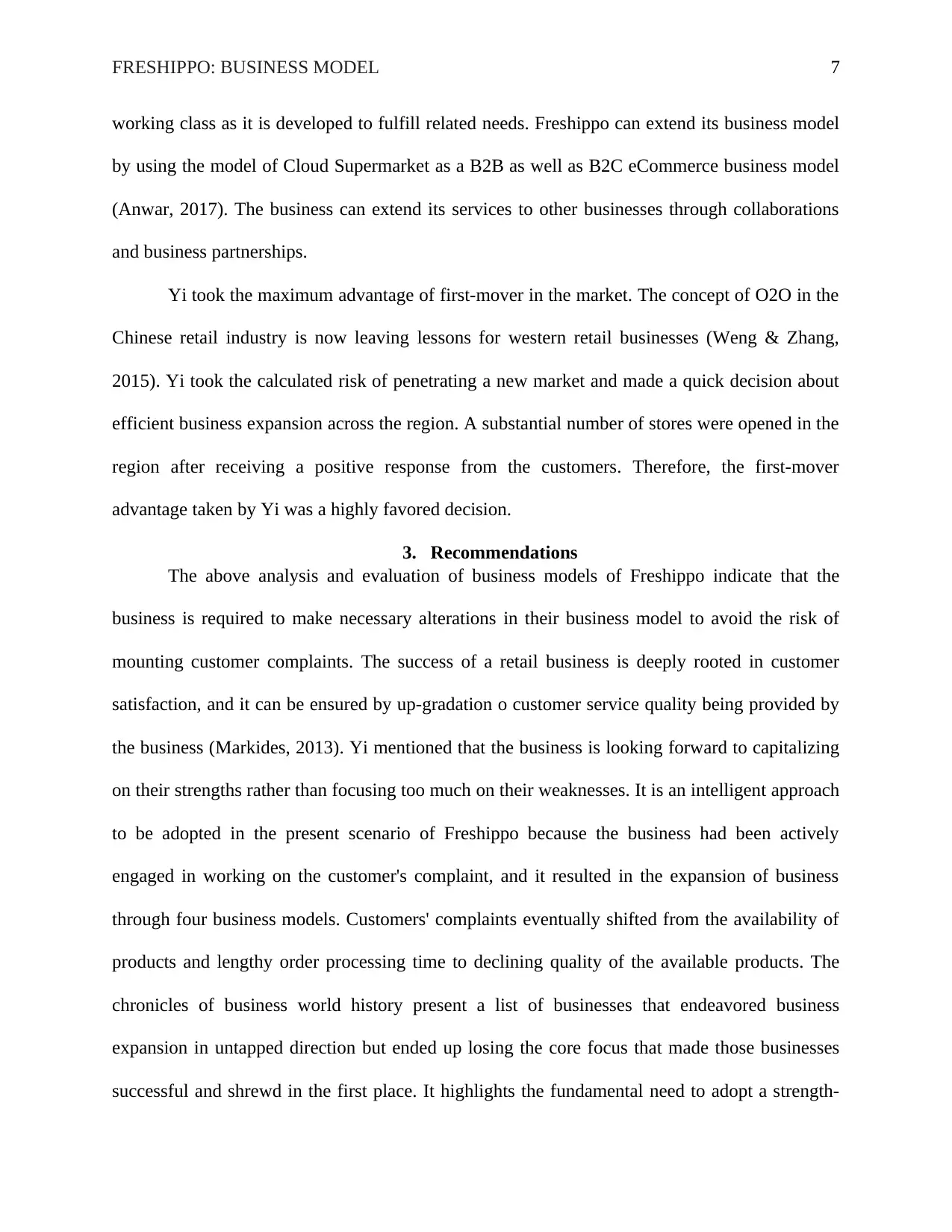
FRESHIPPO: BUSINESS MODEL 7
working class as it is developed to fulfill related needs. Freshippo can extend its business model
by using the model of Cloud Supermarket as a B2B as well as B2C eCommerce business model
(Anwar, 2017). The business can extend its services to other businesses through collaborations
and business partnerships.
Yi took the maximum advantage of first-mover in the market. The concept of O2O in the
Chinese retail industry is now leaving lessons for western retail businesses (Weng & Zhang,
2015). Yi took the calculated risk of penetrating a new market and made a quick decision about
efficient business expansion across the region. A substantial number of stores were opened in the
region after receiving a positive response from the customers. Therefore, the first-mover
advantage taken by Yi was a highly favored decision.
3. Recommendations
The above analysis and evaluation of business models of Freshippo indicate that the
business is required to make necessary alterations in their business model to avoid the risk of
mounting customer complaints. The success of a retail business is deeply rooted in customer
satisfaction, and it can be ensured by up-gradation o customer service quality being provided by
the business (Markides, 2013). Yi mentioned that the business is looking forward to capitalizing
on their strengths rather than focusing too much on their weaknesses. It is an intelligent approach
to be adopted in the present scenario of Freshippo because the business had been actively
engaged in working on the customer's complaint, and it resulted in the expansion of business
through four business models. Customers' complaints eventually shifted from the availability of
products and lengthy order processing time to declining quality of the available products. The
chronicles of business world history present a list of businesses that endeavored business
expansion in untapped direction but ended up losing the core focus that made those businesses
successful and shrewd in the first place. It highlights the fundamental need to adopt a strength-
working class as it is developed to fulfill related needs. Freshippo can extend its business model
by using the model of Cloud Supermarket as a B2B as well as B2C eCommerce business model
(Anwar, 2017). The business can extend its services to other businesses through collaborations
and business partnerships.
Yi took the maximum advantage of first-mover in the market. The concept of O2O in the
Chinese retail industry is now leaving lessons for western retail businesses (Weng & Zhang,
2015). Yi took the calculated risk of penetrating a new market and made a quick decision about
efficient business expansion across the region. A substantial number of stores were opened in the
region after receiving a positive response from the customers. Therefore, the first-mover
advantage taken by Yi was a highly favored decision.
3. Recommendations
The above analysis and evaluation of business models of Freshippo indicate that the
business is required to make necessary alterations in their business model to avoid the risk of
mounting customer complaints. The success of a retail business is deeply rooted in customer
satisfaction, and it can be ensured by up-gradation o customer service quality being provided by
the business (Markides, 2013). Yi mentioned that the business is looking forward to capitalizing
on their strengths rather than focusing too much on their weaknesses. It is an intelligent approach
to be adopted in the present scenario of Freshippo because the business had been actively
engaged in working on the customer's complaint, and it resulted in the expansion of business
through four business models. Customers' complaints eventually shifted from the availability of
products and lengthy order processing time to declining quality of the available products. The
chronicles of business world history present a list of businesses that endeavored business
expansion in untapped direction but ended up losing the core focus that made those businesses
successful and shrewd in the first place. It highlights the fundamental need to adopt a strength-
Paraphrase This Document
Need a fresh take? Get an instant paraphrase of this document with our AI Paraphraser

FRESHIPPO: BUSINESS MODEL 8
based approach. This strategic solution can save the business from indulging in distractions
(Shaked, 2013). By focusing on business strengths, Freshippo may become able to solve its
weaknesses in the future. However, it is a known fact that perfection cannot be achieved.
Freshippo should continue to focus on the constant local demands of the ready availability of
fresh food items and create customer value through innovation in the business model (Amit &
Zott, 2012). Freshness should not be comprised at any cost, and Freshippo should continue to
follow its strategy of building close customer connections through value creation and customer-
oriented corporate behavior. Therefore, it is a recommended approach to fortify business
strengths, which can overshadow the weaknesses of the business.
4. Conclusion
Freshippo is a business of Alibaba group that is focused on catering to the innate demand
for fresh produce by the Chinese customers. The company has revolutionized the retail business
industry, but over time as the demand increased, Freshippo faced a backlash of its customers.
Major problems faced by the customers were related to poor customer service, long waiting
hours, and other related management issues. The business opened new stores keeping in view the
complaints of customers that resulted in four new business models. However, customer
complaints remained persistent. The 'New Retail' strategy by Alibaba is intending to transform or
alter existing business models. The analysis and evaluation of the present situation of business
models indicate that Yi should adopt a strength-focused approach by capitalizing heavily on the
strengths of business rather than its weaknesses.
based approach. This strategic solution can save the business from indulging in distractions
(Shaked, 2013). By focusing on business strengths, Freshippo may become able to solve its
weaknesses in the future. However, it is a known fact that perfection cannot be achieved.
Freshippo should continue to focus on the constant local demands of the ready availability of
fresh food items and create customer value through innovation in the business model (Amit &
Zott, 2012). Freshness should not be comprised at any cost, and Freshippo should continue to
follow its strategy of building close customer connections through value creation and customer-
oriented corporate behavior. Therefore, it is a recommended approach to fortify business
strengths, which can overshadow the weaknesses of the business.
4. Conclusion
Freshippo is a business of Alibaba group that is focused on catering to the innate demand
for fresh produce by the Chinese customers. The company has revolutionized the retail business
industry, but over time as the demand increased, Freshippo faced a backlash of its customers.
Major problems faced by the customers were related to poor customer service, long waiting
hours, and other related management issues. The business opened new stores keeping in view the
complaints of customers that resulted in four new business models. However, customer
complaints remained persistent. The 'New Retail' strategy by Alibaba is intending to transform or
alter existing business models. The analysis and evaluation of the present situation of business
models indicate that Yi should adopt a strength-focused approach by capitalizing heavily on the
strengths of business rather than its weaknesses.
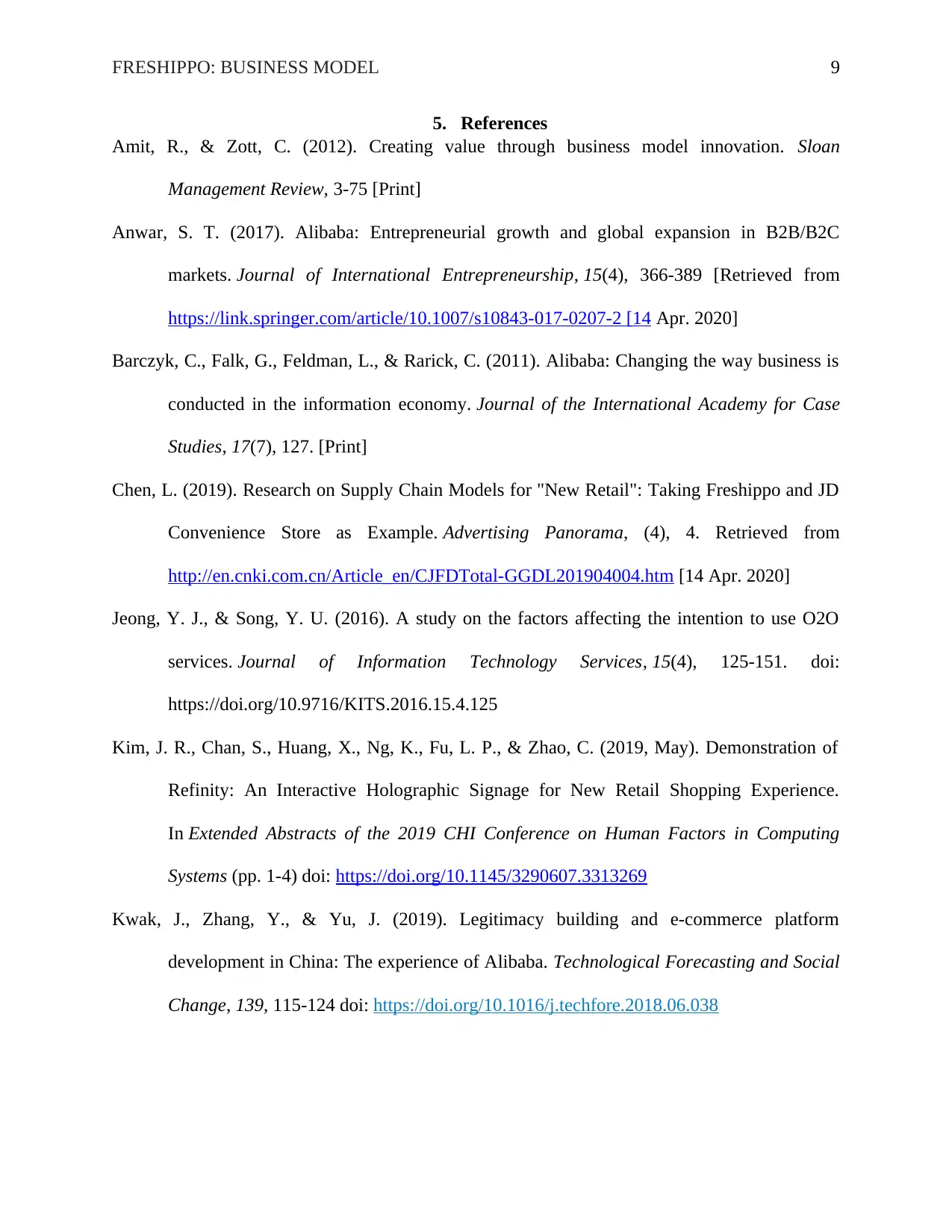
FRESHIPPO: BUSINESS MODEL 9
5. References
Amit, R., & Zott, C. (2012). Creating value through business model innovation. Sloan
Management Review, 3-75 [Print]
Anwar, S. T. (2017). Alibaba: Entrepreneurial growth and global expansion in B2B/B2C
markets. Journal of International Entrepreneurship, 15(4), 366-389 [Retrieved from
https://link.springer.com/article/10.1007/s10843-017-0207-2 [14 Apr. 2020]
Barczyk, C., Falk, G., Feldman, L., & Rarick, C. (2011). Alibaba: Changing the way business is
conducted in the information economy. Journal of the International Academy for Case
Studies, 17(7), 127. [Print]
Chen, L. (2019). Research on Supply Chain Models for "New Retail": Taking Freshippo and JD
Convenience Store as Example. Advertising Panorama, (4), 4. Retrieved from
http://en.cnki.com.cn/Article_en/CJFDTotal-GGDL201904004.htm [14 Apr. 2020]
Jeong, Y. J., & Song, Y. U. (2016). A study on the factors affecting the intention to use O2O
services. Journal of Information Technology Services, 15(4), 125-151. doi:
https://doi.org/10.9716/KITS.2016.15.4.125
Kim, J. R., Chan, S., Huang, X., Ng, K., Fu, L. P., & Zhao, C. (2019, May). Demonstration of
Refinity: An Interactive Holographic Signage for New Retail Shopping Experience.
In Extended Abstracts of the 2019 CHI Conference on Human Factors in Computing
Systems (pp. 1-4) doi: https://doi.org/10.1145/3290607.3313269
Kwak, J., Zhang, Y., & Yu, J. (2019). Legitimacy building and e-commerce platform
development in China: The experience of Alibaba. Technological Forecasting and Social
Change, 139, 115-124 doi: https://doi.org/10.1016/j.techfore.2018.06.038
5. References
Amit, R., & Zott, C. (2012). Creating value through business model innovation. Sloan
Management Review, 3-75 [Print]
Anwar, S. T. (2017). Alibaba: Entrepreneurial growth and global expansion in B2B/B2C
markets. Journal of International Entrepreneurship, 15(4), 366-389 [Retrieved from
https://link.springer.com/article/10.1007/s10843-017-0207-2 [14 Apr. 2020]
Barczyk, C., Falk, G., Feldman, L., & Rarick, C. (2011). Alibaba: Changing the way business is
conducted in the information economy. Journal of the International Academy for Case
Studies, 17(7), 127. [Print]
Chen, L. (2019). Research on Supply Chain Models for "New Retail": Taking Freshippo and JD
Convenience Store as Example. Advertising Panorama, (4), 4. Retrieved from
http://en.cnki.com.cn/Article_en/CJFDTotal-GGDL201904004.htm [14 Apr. 2020]
Jeong, Y. J., & Song, Y. U. (2016). A study on the factors affecting the intention to use O2O
services. Journal of Information Technology Services, 15(4), 125-151. doi:
https://doi.org/10.9716/KITS.2016.15.4.125
Kim, J. R., Chan, S., Huang, X., Ng, K., Fu, L. P., & Zhao, C. (2019, May). Demonstration of
Refinity: An Interactive Holographic Signage for New Retail Shopping Experience.
In Extended Abstracts of the 2019 CHI Conference on Human Factors in Computing
Systems (pp. 1-4) doi: https://doi.org/10.1145/3290607.3313269
Kwak, J., Zhang, Y., & Yu, J. (2019). Legitimacy building and e-commerce platform
development in China: The experience of Alibaba. Technological Forecasting and Social
Change, 139, 115-124 doi: https://doi.org/10.1016/j.techfore.2018.06.038
⊘ This is a preview!⊘
Do you want full access?
Subscribe today to unlock all pages.

Trusted by 1+ million students worldwide
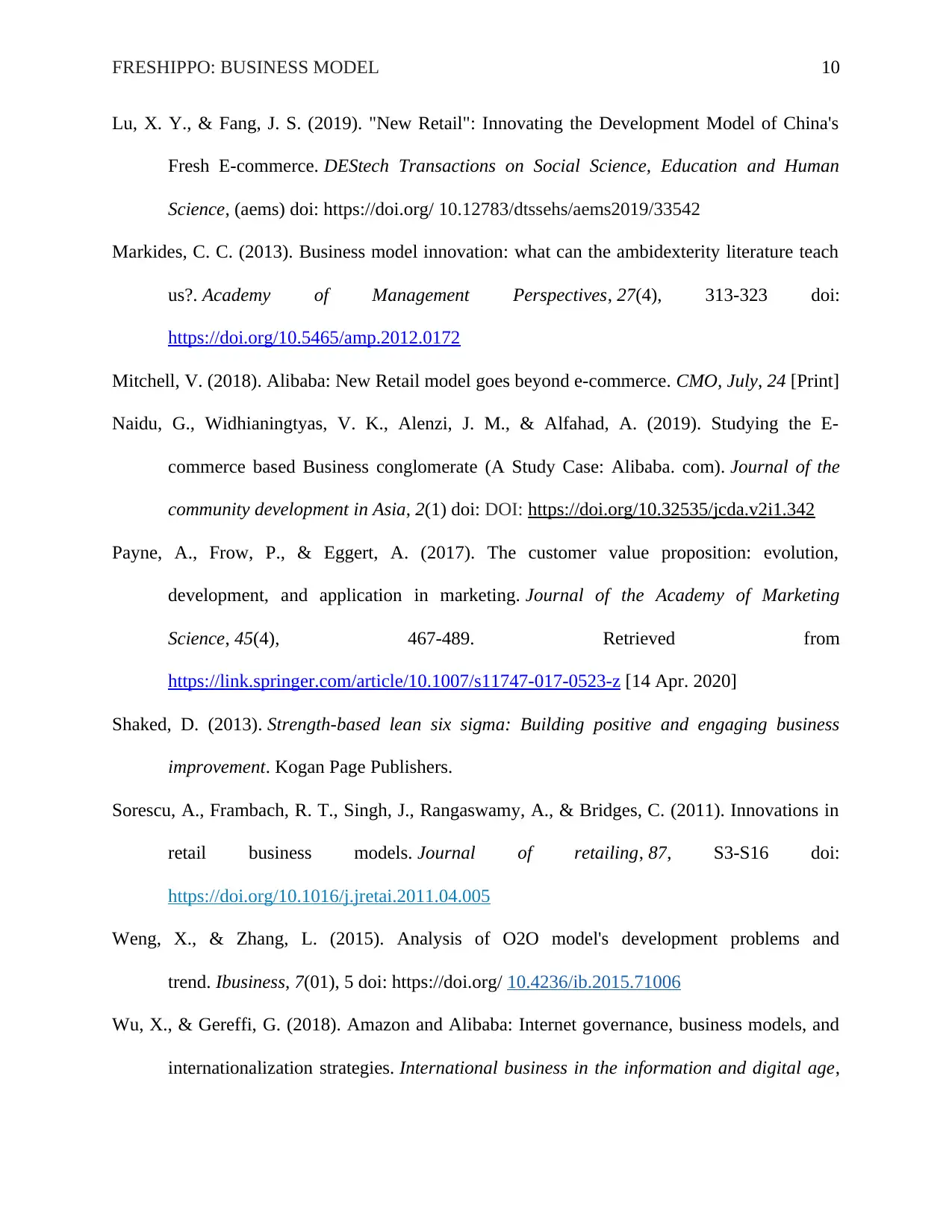
FRESHIPPO: BUSINESS MODEL 10
Lu, X. Y., & Fang, J. S. (2019). "New Retail": Innovating the Development Model of China's
Fresh E-commerce. DEStech Transactions on Social Science, Education and Human
Science, (aems) doi: https://doi.org/ 10.12783/dtssehs/aems2019/33542
Markides, C. C. (2013). Business model innovation: what can the ambidexterity literature teach
us?. Academy of Management Perspectives, 27(4), 313-323 doi:
https://doi.org/10.5465/amp.2012.0172
Mitchell, V. (2018). Alibaba: New Retail model goes beyond e-commerce. CMO, July, 24 [Print]
Naidu, G., Widhianingtyas, V. K., Alenzi, J. M., & Alfahad, A. (2019). Studying the E-
commerce based Business conglomerate (A Study Case: Alibaba. com). Journal of the
community development in Asia, 2(1) doi: DOI: https://doi.org/10.32535/jcda.v2i1.342
Payne, A., Frow, P., & Eggert, A. (2017). The customer value proposition: evolution,
development, and application in marketing. Journal of the Academy of Marketing
Science, 45(4), 467-489. Retrieved from
https://link.springer.com/article/10.1007/s11747-017-0523-z [14 Apr. 2020]
Shaked, D. (2013). Strength-based lean six sigma: Building positive and engaging business
improvement. Kogan Page Publishers.
Sorescu, A., Frambach, R. T., Singh, J., Rangaswamy, A., & Bridges, C. (2011). Innovations in
retail business models. Journal of retailing, 87, S3-S16 doi:
https://doi.org/10.1016/j.jretai.2011.04.005
Weng, X., & Zhang, L. (2015). Analysis of O2O model's development problems and
trend. Ibusiness, 7(01), 5 doi: https://doi.org/ 10.4236/ib.2015.71006
Wu, X., & Gereffi, G. (2018). Amazon and Alibaba: Internet governance, business models, and
internationalization strategies. International business in the information and digital age,
Lu, X. Y., & Fang, J. S. (2019). "New Retail": Innovating the Development Model of China's
Fresh E-commerce. DEStech Transactions on Social Science, Education and Human
Science, (aems) doi: https://doi.org/ 10.12783/dtssehs/aems2019/33542
Markides, C. C. (2013). Business model innovation: what can the ambidexterity literature teach
us?. Academy of Management Perspectives, 27(4), 313-323 doi:
https://doi.org/10.5465/amp.2012.0172
Mitchell, V. (2018). Alibaba: New Retail model goes beyond e-commerce. CMO, July, 24 [Print]
Naidu, G., Widhianingtyas, V. K., Alenzi, J. M., & Alfahad, A. (2019). Studying the E-
commerce based Business conglomerate (A Study Case: Alibaba. com). Journal of the
community development in Asia, 2(1) doi: DOI: https://doi.org/10.32535/jcda.v2i1.342
Payne, A., Frow, P., & Eggert, A. (2017). The customer value proposition: evolution,
development, and application in marketing. Journal of the Academy of Marketing
Science, 45(4), 467-489. Retrieved from
https://link.springer.com/article/10.1007/s11747-017-0523-z [14 Apr. 2020]
Shaked, D. (2013). Strength-based lean six sigma: Building positive and engaging business
improvement. Kogan Page Publishers.
Sorescu, A., Frambach, R. T., Singh, J., Rangaswamy, A., & Bridges, C. (2011). Innovations in
retail business models. Journal of retailing, 87, S3-S16 doi:
https://doi.org/10.1016/j.jretai.2011.04.005
Weng, X., & Zhang, L. (2015). Analysis of O2O model's development problems and
trend. Ibusiness, 7(01), 5 doi: https://doi.org/ 10.4236/ib.2015.71006
Wu, X., & Gereffi, G. (2018). Amazon and Alibaba: Internet governance, business models, and
internationalization strategies. International business in the information and digital age,
Paraphrase This Document
Need a fresh take? Get an instant paraphrase of this document with our AI Paraphraser
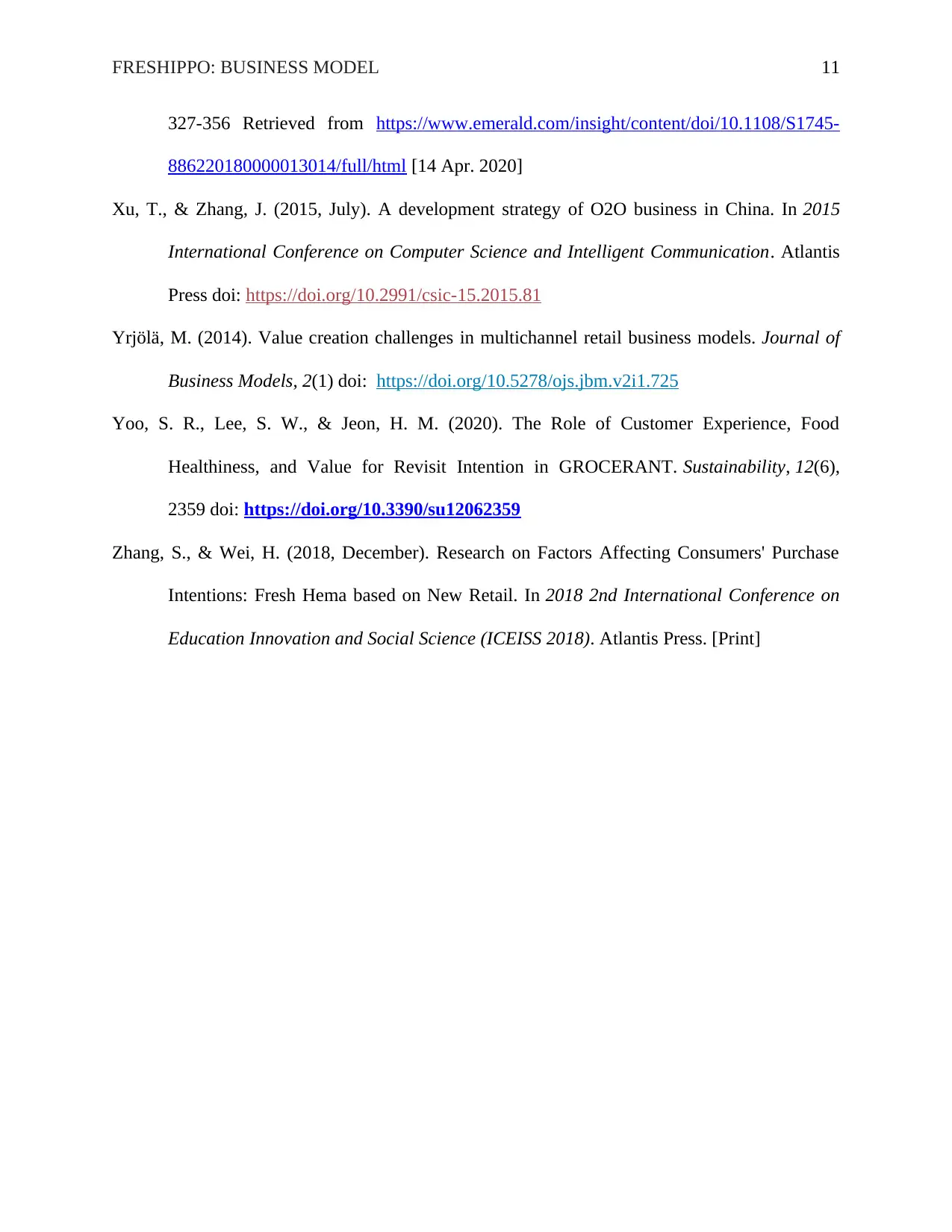
FRESHIPPO: BUSINESS MODEL 11
327-356 Retrieved from https://www.emerald.com/insight/content/doi/10.1108/S1745-
886220180000013014/full/html [14 Apr. 2020]
Xu, T., & Zhang, J. (2015, July). A development strategy of O2O business in China. In 2015
International Conference on Computer Science and Intelligent Communication. Atlantis
Press doi: https://doi.org/10.2991/csic-15.2015.81
Yrjölä, M. (2014). Value creation challenges in multichannel retail business models. Journal of
Business Models, 2(1) doi: https://doi.org/10.5278/ojs.jbm.v2i1.725
Yoo, S. R., Lee, S. W., & Jeon, H. M. (2020). The Role of Customer Experience, Food
Healthiness, and Value for Revisit Intention in GROCERANT. Sustainability, 12(6),
2359 doi: https://doi.org/10.3390/su12062359
Zhang, S., & Wei, H. (2018, December). Research on Factors Affecting Consumers' Purchase
Intentions: Fresh Hema based on New Retail. In 2018 2nd International Conference on
Education Innovation and Social Science (ICEISS 2018). Atlantis Press. [Print]
327-356 Retrieved from https://www.emerald.com/insight/content/doi/10.1108/S1745-
886220180000013014/full/html [14 Apr. 2020]
Xu, T., & Zhang, J. (2015, July). A development strategy of O2O business in China. In 2015
International Conference on Computer Science and Intelligent Communication. Atlantis
Press doi: https://doi.org/10.2991/csic-15.2015.81
Yrjölä, M. (2014). Value creation challenges in multichannel retail business models. Journal of
Business Models, 2(1) doi: https://doi.org/10.5278/ojs.jbm.v2i1.725
Yoo, S. R., Lee, S. W., & Jeon, H. M. (2020). The Role of Customer Experience, Food
Healthiness, and Value for Revisit Intention in GROCERANT. Sustainability, 12(6),
2359 doi: https://doi.org/10.3390/su12062359
Zhang, S., & Wei, H. (2018, December). Research on Factors Affecting Consumers' Purchase
Intentions: Fresh Hema based on New Retail. In 2018 2nd International Conference on
Education Innovation and Social Science (ICEISS 2018). Atlantis Press. [Print]
1 out of 11
Related Documents
Your All-in-One AI-Powered Toolkit for Academic Success.
+13062052269
info@desklib.com
Available 24*7 on WhatsApp / Email
![[object Object]](/_next/static/media/star-bottom.7253800d.svg)
Unlock your academic potential
Copyright © 2020–2025 A2Z Services. All Rights Reserved. Developed and managed by ZUCOL.





